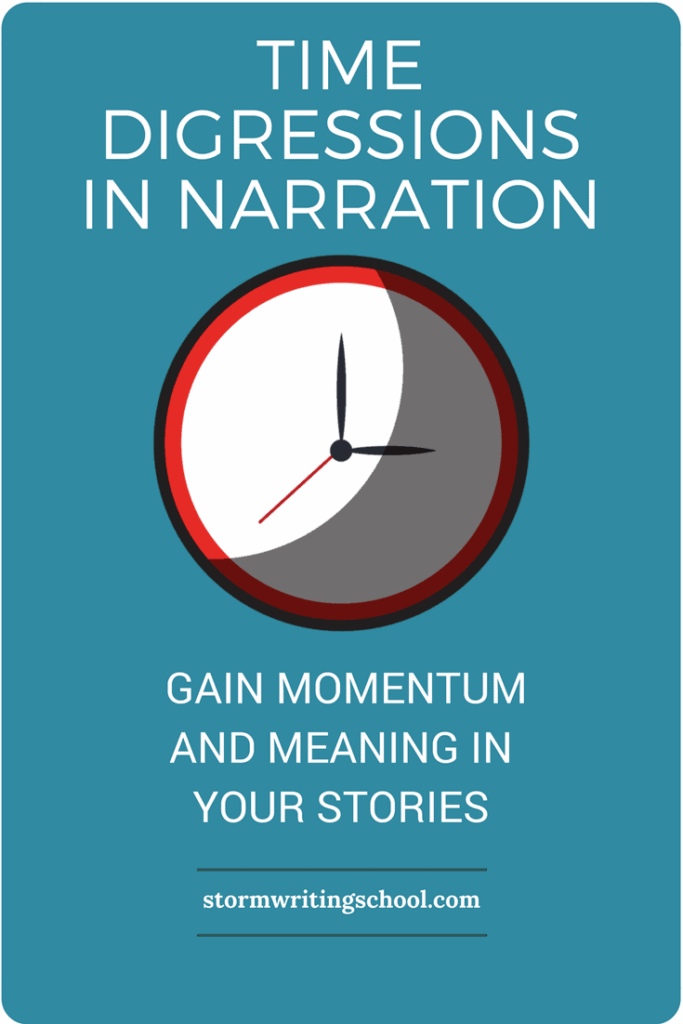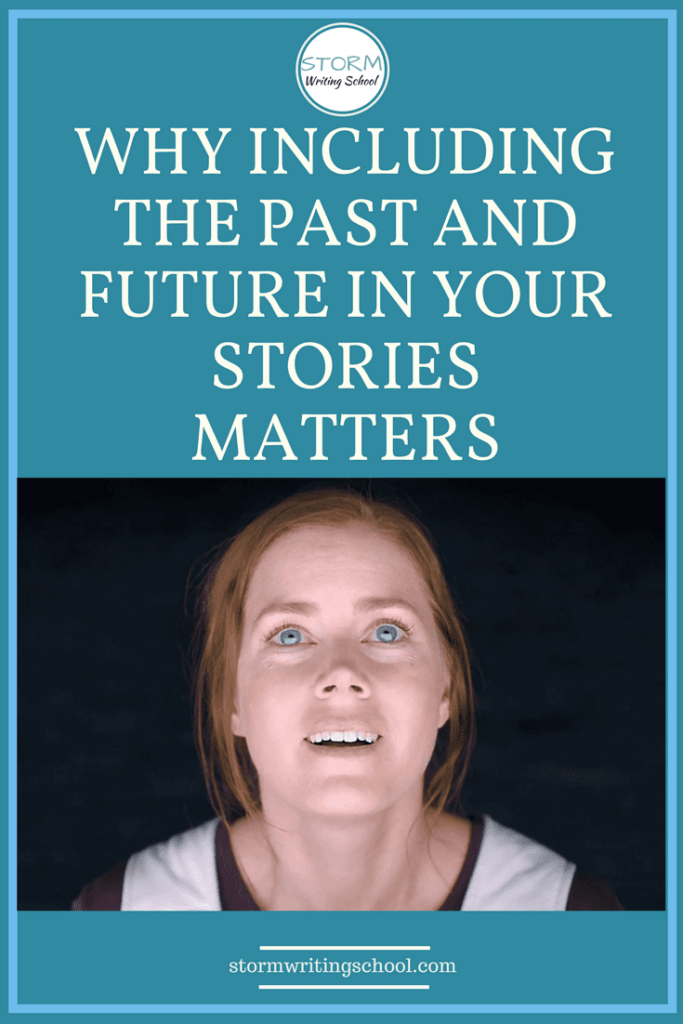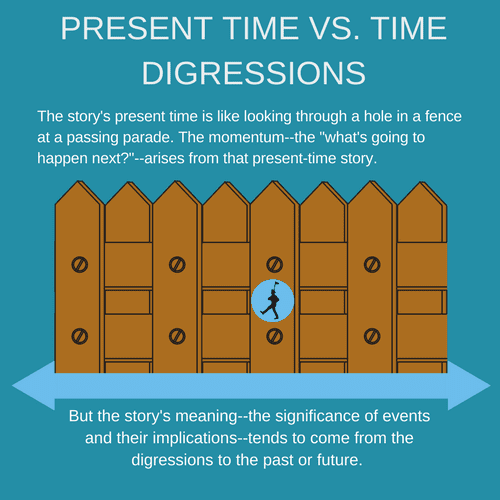Manipulate time in your narration to gain both momentum and meaning
I introduced this concept of present-time story vs. digression in time in my post on the four ways to break down page-level craft. The previous article in this series addressed scene vs. summary. This is the second narration breakdown. When I say “time digressions,” I’m referring to any break from a present-time scene to the past or the future. Flashbacks, quick memories, flash forwards—those are time digressions.
Here, in more detail, is what time digressions are all about.


Let’s begin with the obvious: stories jump around in time a bit. Take a look at this piece of flash fiction:
Ghost in the Valley
We had a white barn cat named Ghost who disappeared when I was six. Mom said she saw a hawk take him away. I pictured the two of them—the cat and the hawk—soaring over the valley like a couple of tandem hang gliders. I told Mom I bet Ghost liked flying. “Oh, honey,” she said. She covered her mouth with her hand. And then my older brother Jason, who’d been eavesdropping from across the room, laughed and said, “You’re the weirdest little kid.” I could see Mom’s smile spilling around the hand covering her mouth.
I ran out the door to the barn where Ghost used to hunt mice. Mom called after me.
I climbed the ladder to the hay loft and meowed, hoping to see Ghost emerge from some dark corner, arching his white back in anticipation of a scratch. Over the bales of hay I crawled, with stray spires pricking my palms and knees. And then I opened the loft door and sat at the ledge, letting my legs dangle.
The barn looked out over a valley that years later would flood when torrential rains made the rivers swell. I squinted into the distance, willing superpower vision to reveal Ghost stalking mice in the fields or soaring over treetops with his buddy the hawk. But it was a foggy morning, and no hawk’s vision would help me find my lost cat.
There were so many things I couldn’t see in those days—like the liquor Jason stole from the kitchen cabinet or the late night conversations between Mom and Dad over the piles of past-due bills. So many things weren’t ever going to come back. But what did I know? I imagined flying over the foggy treetops, gripped by a hawk who I thought was my friend, and stretching my padded paws earthward toward home.
The Time Digressions
It’s clear that there’s some jumping around in time here, yes? The narrator is older than the character and is looking back upon an experience he or she had as a child.
So we begin the story with a retrospective: “We had a white barn cat named Ghost, who disappeared when I was six.” That sentence moves from narrator to character and transitions us into the story’s actual “present-time”—that is, the present as the child protagonist experiences it.
We then go quite a ways into this very short story before we get our next digression from the present time with “that years later would flood when torrential rains made the rivers swell.”
Now, this is a bit unusual: because we have a retrospective narrator, this digression in time is a flash forward from the character’s “present-time.” It functions a lot like a flash back, however.
And then in the final paragraph, we get the same kind of flash forward-functioning-like-a-flashback when the narrator interrupts the present-time story with “There were so many things I couldn’t see in those days. . . . So many things weren’t ever going to come back.” Jason’s stealing liquor and the parents arguing about finances are summarized events that depart from the story’s present time.
Momentum and Meaning
So, first of all, it’s worth noting that most of the story’s momentum comes from the “What’s going to happen next?” question, and that’s a question that arises from present-time story. Most of the story’s meaning, however, arises from the time digressions. The child protagonist of this story doesn’t understand the true nature of tragedy and loss. But s/he will.
Look back over the story, taking out any digression in time. It’s a much more simplistic, less meaningful piece without those digressions. Here it is in pure present-time story:
We had a white barn cat named Ghost who disappeared when I was six. Mom said she saw a hawk take him away. I pictured the two of them—the cat and the hawk—soaring over the valley like a couple of tandem hang gliders. I told Mom I bet Ghost liked flying. “Oh, honey,” she said. She covered her mouth with her hand. And then my older brother Jason, who’d been eavesdropping from across the room, laughed and said, “You’re the weirdest little kid.” I could see Mom’s smile spilling around the hand covering her mouth.
I ran out the door to the barn where Ghost used to hunt mice. Mom called after me.
I climbed the ladder to the hay loft and meowed, hoping to see Ghost emerge from some dark corner, arching his white back in anticipation of a scratch. Over the bales of hay I crawled, with stray spires pricking my palms and knees. And then I opened the loft door and sat at the ledge, letting my legs dangle.
The barn looked out over a valley. I squinted into the distance, willing superpower vision to reveal Ghost stalking mice in the fields or soaring over treetops with his buddy the hawk. But it was a foggy morning, and no hawk’s vision would help me find my lost cat.
I imagined flying over the foggy treetops, gripped by a hawk who I thought was my friend, and stretching my padded paws earthward toward home.
You’ll notice that the actual story looks pretty much the same because the bulk of the original story was in present-time. But what does this second version mean? Where does it leave us? It’s an incredibly dissatisfying little piece without the digressions in time, isn’t it?
The Value of Time Digressions
I’ve seen writing that departs very little from the story’s present time, and such stories tend to be somewhat empty. In Story Genius, Lisa Cron argues that the character’s past is what gives context—and therefore meaning—to the character’s actions and desires:
After all, a rose is never just a rose. It’s a sign of love from the cute guy next door—which makes it a wonder to behold. It’s a wilted last-minute gift from your husband on your tenth anniversary—which makes it a major disappointment. It’s what you were supposed to bring your girlfriend, but forgot, so it’s the reason she broke up with you—which makes it a thorny reminder of your flaws. What do all these examples have in common? The rose got its meaning based on things that happened in the past, before it was presented (or not) to the recipient. The past determines the present. . . . Without the past to provide context, that rose is just a plain old pretty flower, and who cares about that?
So should you have time digressions? Definitely. They create meaning and therefore can add to the story momentum because they’ll get us caring about the protagonist more and they may also get us more aware of the stakes of failure to achieve the objective.

A Caution Against Too Much
But certainly some writing gets way too bogged down in the past, neglecting the present-time story. Even if such past is interesting, it’s not spurring the reader to ask, “What’s going to happen next?” The reader will wander too far away from that driving story question (which is rooted in the character’s striving after a goal and facing obstacles), and the story’s momentum will flounder.
So the trick is to balance the two and to be careful not to let your time digressions take us away from the present-time story’s urgency. Your time digressions should serve the present-time narrative.
Three key questions to ask of your time digressions:
Look over a scene or sequence of yours (or a peers’) and first take note of your time digressions. Underline or highlight them. Then evaluate:
- Are any of the time digressions distracting from the present-time story, making a reader lose sight of the present-time desire track?
- If you took out the time digressions, would the scene or sequence suffer? Would it lose some significance, impact, power?
- Is the writer transitioning fluidly into and out of the time digressions?
SaveSave
SaveSave
SaveSave
SaveSave
SaveSave
SaveSave
SaveSave
SaveSave
SaveSave
SaveSave
SaveSave
SaveSave
SaveSave





5 Responses